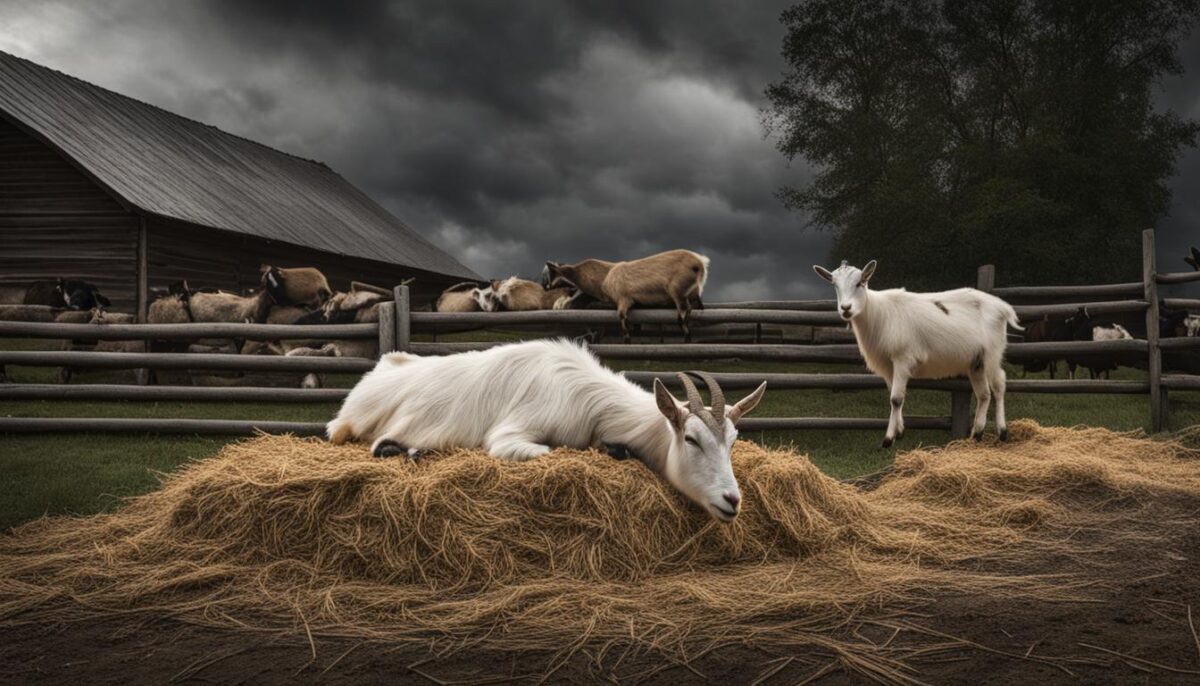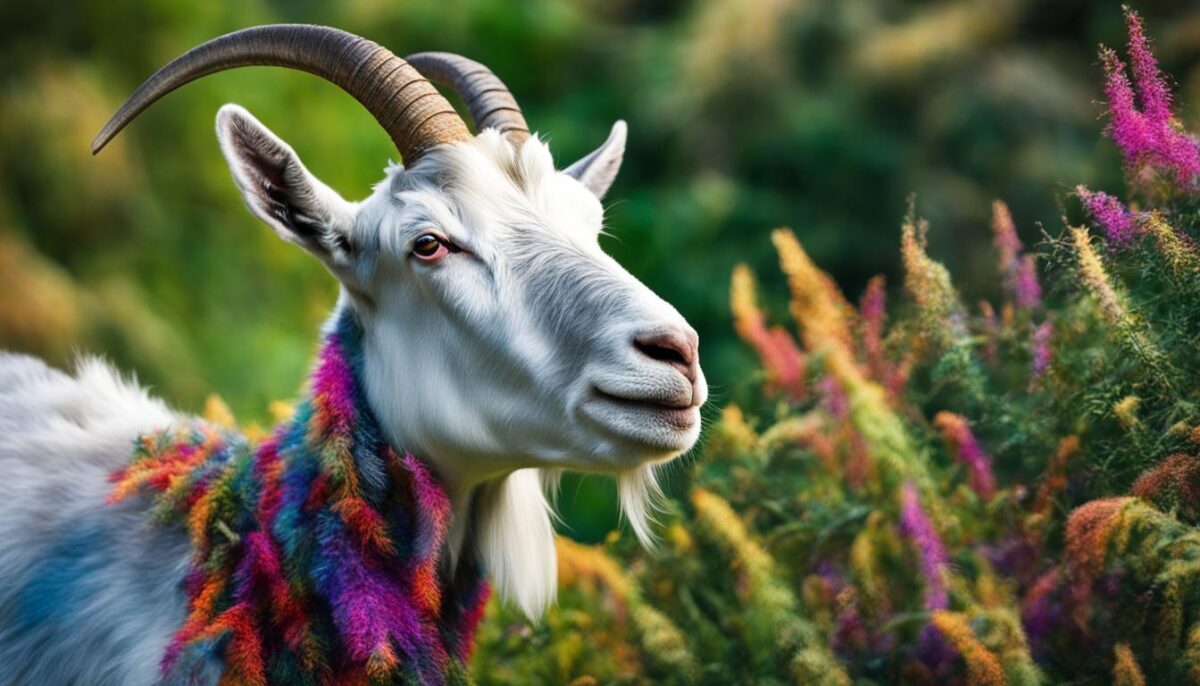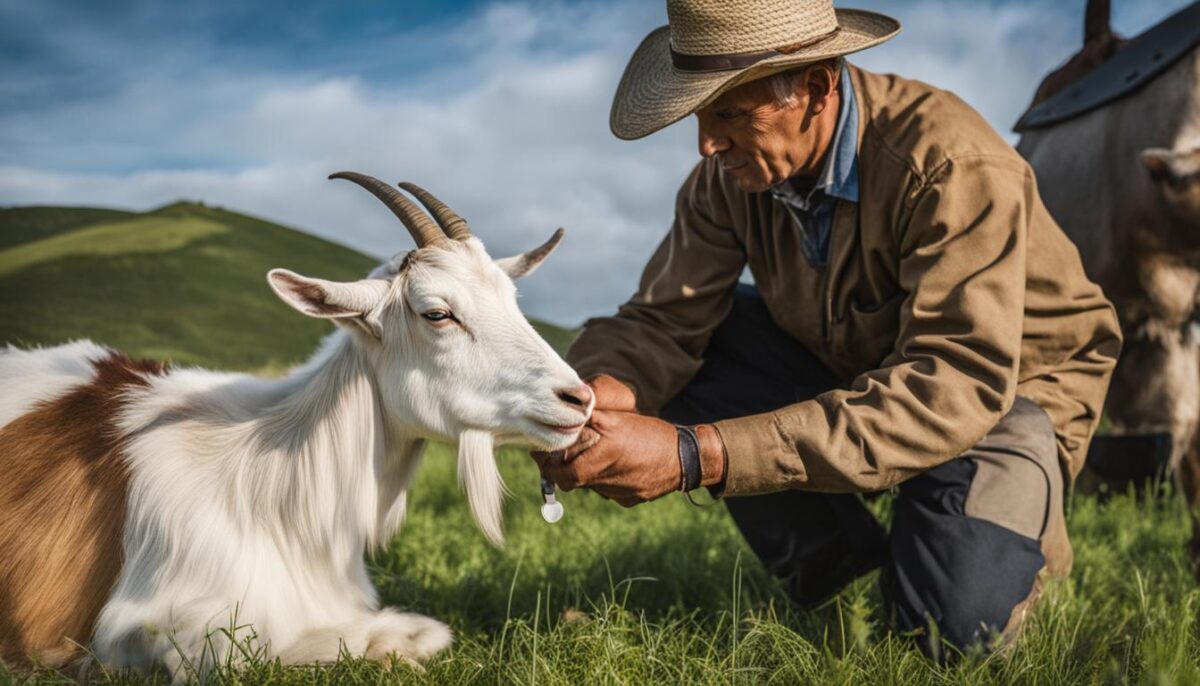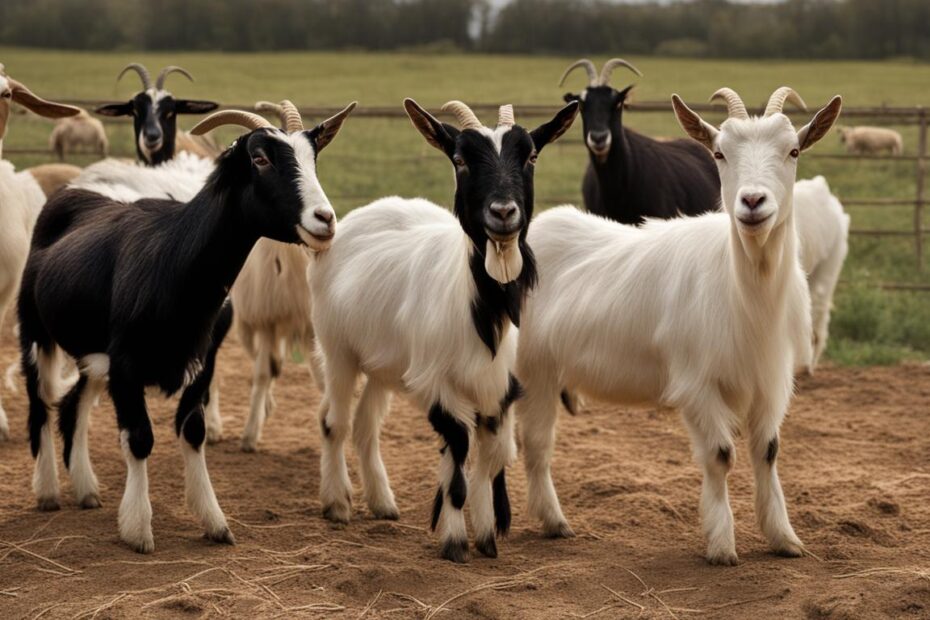When it comes to goat health, it’s important for owners to be aware of the signs of illness and diseases that can affect their animals. One such symptom that may indicate a problem is goats foaming at the mouth. This foaming can be a sign of a serious condition called bloat, which can quickly become life-threatening if not addressed promptly.
Bloat occurs when the fermentation process inside a goat’s rumen, a complex digestive organ, is disrupted, leading to the buildup of gas. The signs of bloat in goats include a distended abdomen, lack of appetite, discomfort, bleating, grinding teeth, and difficulty breathing. It can be caused by obstructions in the throat or esophagus, eating inappropriate or unfamiliar foods, or excessive consumption of soluble carbohydrates.
To treat bloat, options include relieving gas through stomach tubes or veterinary interventions like rumen puncture. However, prevention is key. Providing a suitable diet and environment for goats can help prevent bloat and other illnesses. By understanding the symptoms, causes, and treatment options for goats foaming at the mouth, goat owners can ensure the health and well-being of their animals.
Key Takeaways:
- Goats foaming at the mouth could be a sign of bloat, a serious condition that requires immediate attention.
- The symptoms of bloat include a distended abdomen, lack of appetite, discomfort, and difficulty breathing.
- Bloat can be caused by obstructions in the throat or esophagus, eating inappropriate or unfamiliar foods, or excessive consumption of soluble carbohydrates.
- Treatment options for bloat include relieving gas through stomach tubes or veterinary interventions like rumen puncture.
- Prevention is important and can be achieved by providing a suitable diet and environment for goats.
Signs and Symptoms of Goats Foaming at the Mouth
When goats experience bloat, one of the common symptoms is foaming at the mouth. It is essential for goat owners to be able to recognize the signs and symptoms of this condition to provide timely intervention. The signs of bloat in goats include lack of appetite, discomfort, abdominal distention, grinding teeth, and difficulty breathing. However, foaming at the mouth is a specific symptom that indicates respiratory distress and an urgent need for attention.
Other signs of goats foaming at the mouth include abdominal inflation high on the left side, pain or tense facial muscles, frequent urination, stilted walk, and lying down. These symptoms may occur progressively as the condition worsens and can vary in severity. The buildup of gas in the rumen puts pressure on the lungs, leading to respiratory distress and making it hard for the goat to breathe.
“Foaming at the mouth is a definitive sign of respiratory distress in goats experiencing bloat. It indicates the buildup of gas in the rumen, which can put pressure on the lungs and lead to potentially life-threatening complications.”
Recognizing these signs and symptoms is crucial for taking immediate action and seeking veterinary assistance. Failure to address bloat promptly can result in the condition worsening within a few hours and posing a significant threat to the goat’s health and well-being.
| Signs and Symptoms of Goats Foaming at the Mouth | |
|---|---|
| Lack of appetite | Abdominal inflation high on the left side |
| Discomfort | Pain or tense facial muscles |
| Grinding teeth | Frequent urination |
| Difficulty breathing | Stilted walk |
| Abdominal distention | Lying down |
Causes of Goat Bloat: Obstructions and Diet Changes
Goats foaming at the mouth can be caused by various factors, including obstructions in the esophagus and changes in their diet. Obstructions can occur when a goat ingests something large that gets stuck in the throat or esophagus, blocking the escape of gas from the rumen. This can include chunks of vegetables or other foreign objects. Consumption of inappropriate food or sudden diet changes can also lead to bloat in goats. For example, grazing on legume pastures or excessive consumption of grains can disrupt the balance of the rumen and result in the production of foam.
Ingesting legumes, such as clover or alfalfa, can be particularly problematic for goats as they contain high levels of soluble carbohydrates. When goats graze on legume-dominant pastures, the consumption of these carbohydrates can cause excessive gas production and foaming in the rumen. Similarly, an abrupt increase in grain intake can overwhelm the rumen’s capacity to digest and process the carbohydrates, leading to bloat. It’s important for goat owners to be mindful of their animals’ diet and avoid sudden or excessive changes that can trigger this condition.
Table:
| Causes of Goat Bloat | Examples |
|---|---|
| Obstructions in the esophagus | Ingestion of large objects or chunks of vegetables |
| Consumption of inappropriate food | Grazing on legume pastures |
| Diet changes | Excessive grain consumption |
| Legume pastures | Clover, alfalfa |
| Grain overload | Abrupt increase in grain intake |
| Soluble carbohydrates | Carbohydrates causing excessive gas production |
| Bloat from grazing on pasture | Ingestion of foaming agents in the pasture |
By understanding the causes of goat bloat, goat owners can take proactive measures to prevent this condition and ensure the well-being of their animals.
Types of Bloat in Goats: Free Gas Bloat and Frothy Bloat
When it comes to bloat in goats, there are two main types to be aware of: free gas bloat and frothy bloat. Understanding the differences between these types can help goat owners identify and address the condition more effectively.
Free gas bloat occurs when there is an obstruction in the throat or esophagus, preventing the escape of gas. This can be caused by an object stuck in the throat or by eating indigestible materials. The buildup of gas in the rumen leads to abdominal distention and other symptoms associated with bloat. On the other hand, frothy bloat is caused by the presence of foam in the rumen that prevents gas from escaping. This type of bloat is more common when goats consume large amounts of rich, high-carbohydrate foods that they are not accustomed to, such as legumes, wet spring grass, and cereals. Leguminous bloat is a specific type of frothy bloat that is usually caused by grazing on legume-dominant pastures.
To further understand the differences between the types of bloat, it is helpful to explore the foaming characteristics. Acute foam, which is associated with frothy bloat, forms quickly and is stable. Intermediate foam, also associated with frothy bloat, forms slower and is less stable. Delayed foam, on the other hand, forms after a period of time and can be unstable. This variation in foaming properties can impact the severity and progression of bloat in goats.
| Type of Bloat | Main Cause | Foaming Characteristics |
|---|---|---|
| Free Gas Bloat | Obstruction in the throat or esophagus | No foam |
| Frothy Bloat | Foam formation in the rumen | Acute foam, Intermediate foam, Delayed foam |
| Leguminous Bloat | Grazing on legume-dominant pastures | Frothy foam |
By understanding the types of bloat in goats and their underlying causes, goat owners can take appropriate measures to prevent and manage the condition, ensuring the health and well-being of their animals.
Treating Bloat in Goats: Relief Measures and Veterinary Intervention
When faced with a case of goats foaming at the mouth due to bloat, there are several treatment options available. Relief measures can be taken to provide temporary relief for the goat. These measures include attempting to remove any obstructions in the throat or esophagus, using a stomach tube to release gas, or massaging the rumen to encourage gas release. These relief measures can help alleviate the discomfort and reduce the distension of the abdomen.
In more severe cases where relief measures are not effective, veterinary intervention may be necessary. Veterinary care can involve more invasive procedures to relieve the bloat. One such procedure is rumen puncture, where the rumen is pierced with a trochar to release gas. This can provide immediate relief for the goat. Veterinary care may also involve the administration of specialized medications, such as poloxalene, which can help break down the foam in the rumen and facilitate the release of gas.
In some cases, when all other measures have failed or are not available, alternative substances like oil of turpentine or dishwashing liquid may be used as a last resort. These substances can help break down the foam and allow for the release of gas. However, it is important to note that these substances should only be used under veterinary supervision, as they can have adverse effects if not administered properly.
| Treatment Options | Description |
|---|---|
| Relief Measures | Attempting to remove obstructions, using a stomach tube, or massaging the rumen |
| Veterinary Intervention | Rumen puncture, administration of specialized medications |
| Alternative Substances | Oil of turpentine or dishwashing liquid (under veterinary supervision) |
It is crucial to seek veterinary care for bloat in goats, as complications can arise, and follow-up care may be necessary. Veterinary professionals have the expertise and tools to properly diagnose and treat the underlying causes of bloat in goats. They can provide the necessary interventions and medications to alleviate the symptoms and prevent further complications. Timely veterinary care can make a significant difference in the outcome for goats foaming at the mouth due to bloat.
Suitable Diet and Grazing Practices to Prevent Bloat in Goats
Preventing bloat in goats is crucial for their overall health and well-being. By implementing suitable dietary considerations and management practices, goat owners can minimize the risk of bloat. A balanced diet is essential, with at least 75% of the diet consisting of long-fiber forage such as hay or pasture. When feeding grains or concentrates, it is important to introduce them gradually and in small quantities over time to avoid digestive disruptions. Avoiding excessive consumption of high-carbohydrate foods, especially legumes, can also help prevent bloat.
Ensuring hay availability is essential in preventing bloat. Hay should be offered to goats before concentrates or turning them out to fresh grass. This helps maintain a healthy rumen environment and prevents overconsumption of high-carbohydrate foods. Additionally, pastures should contain a variety of plants, with legumes interspersed with grass. This diversity in forage helps promote a balanced diet for goats and reduces the risk of bloat.
Implementing suitable grazing practices can also contribute to bloat prevention. Avoiding sudden changes in diet, especially when transitioning from one type of grazing to another, can help goats adapt gradually to new forage sources. This gradual change allows their rumen microbes to adjust appropriately, reducing the risk of bloat. Regular monitoring of grazing areas and removing any potentially toxic or indigestible plants can also contribute to maintaining a safe grazing environment for goats.
| Dietary Considerations | Management Practices |
|---|---|
|
|
By following these dietary considerations and management practices, goat owners can significantly reduce the occurrence of bloat in their animals. Prevention is key in maintaining optimal goat health and minimizing the risk of digestive complications.

The dangers of choke and free gas bloat lie in the potential complications that can arise if left untreated. In the case of choke, the obstructed airway can cause inflammation, leading to difficulty breathing and discomfort for the goat. Failure to address choke promptly can result in further complications and even death. Free gas bloat, on the other hand, can put pressure on the goat’s respiratory and circulatory systems, leading to respiratory distress and circulatory failure. The accumulation of gas in the rumen can quickly become life-threatening, making it crucial to address the situation as soon as possible.
Complications of Bloat
The complications associated with bloat in goats can be severe and should not be overlooked. In addition to the risk of respiratory and circulatory failure, bloat can lead to other medical issues. The distention of the abdomen can interfere with the goat’s ability to eat and drink, leading to nutritional deficiencies and dehydration. The pressure on the internal organs can cause discomfort and pain, impacting the goat’s overall well-being. Additionally, if bloat is left untreated, it can result in secondary infections or damage to the rumen, further exacerbating the goat’s condition.
| Complications of Bloat | Symptoms |
|---|---|
| Respiratory distress | Dyspnea, labored breathing |
| Circulatory failure | Rapid heart rate, weak pulse |
| Nutritional deficiencies | Lack of appetite, weight loss |
| Dehydration | Excessive thirst, dry mucous membranes |
| Discomfort and pain | Restlessness, inability to lie down comfortably |
| Infections | Fever, lethargy, discharge |
It is important to recognize the signs of choke and free gas bloat, such as abdominal distention, dyspnea, and inflammation, in order to provide timely intervention. Seeking veterinary assistance is crucial in addressing these conditions effectively and minimizing the potential complications that can arise from bloat in goats. Prompt treatment can make a significant difference in the goat’s chances of recovery and overall well-being.
Understanding Organophosphate Poisoning and Goats Foaming at the Mouth
Organophosphate poisoning can lead to goats foaming at the mouth, a symptom associated with acute foam, intermediate foam, and delayed foam syndromes. These syndromes occur when the acetylcholinesterase enzyme is inhibited, resulting in increased nervous system activation. Signs of poisoning may include vomiting, diarrhea, salivation, muscle tremors, seizures, and respiratory distress. Acute foam is characterized by muscarinic, nicotinic, and central nervous system signs, while intermediate foam primarily affects muscle weakness. Delayed foam syndrome is associated with degeneration of peripheral and central nervous system axons.
Treatment for organophosphate poisoning in goats involves the use of medications like atropine and pralidoxime chloride. These medications help counteract the effects of organophosphate toxicity by blocking the acetylcholine receptors and reactivating the inhibited acetylcholinesterase enzyme. Veterinary care should be sought immediately if poisoning is suspected, as prompt treatment is crucial to minimize the potential for serious complications and mortality.
To better understand the signs and symptoms of organophosphate poisoning in goats, it is important to be familiar with the various foam syndromes associated with this type of poisoning. Prompt recognition of these symptoms and timely intervention can help ensure the well-being and survival of the affected goats.

| Foam Syndrome | Signs and Symptoms |
|---|---|
| Acute Foam Syndrome | Muscarinic, nicotinic, and central nervous system signs |
| Intermediate Foam Syndrome | Primarily affects muscle weakness |
| Delayed Foam Syndrome | Associated with degeneration of peripheral and central nervous system axons |
Recognizing and Detecting Goats Foaming at the Mouth
Recognizing and detecting goats foaming at the mouth is crucial for identifying cases of bloat and providing timely intervention. Several symptoms can indicate the presence of bloat in goats. Abdominal distention, characterized by a sudden enlargement of the abdomen, is a common sign. Dyspnea, or difficulty breathing, is another symptom to watch for. Goats experiencing bloat may exhibit mouth breathing, protrusion of the tongue, and frequent urination. Changes in rumen motility, such as reduced activity or abnormal contractions, can also indicate the presence of bloat. By being vigilant and observant of these symptoms, goat owners can take prompt action to address the condition.

In addition to these physical symptoms, goat owners should also pay attention to more subtle signs of discomfort and distress. Goats foaming at the mouth may exhibit grunting or bleating, indicating discomfort. They may also display a stilted or abnormal gait, reflecting the impact of bloat on their overall well-being. By being aware of these behavioral changes, goat owners can intervene early and seek appropriate treatment for their animals.
It’s important to note that while these symptoms may indicate the presence of bloat, a proper diagnosis should be made by a veterinarian. Veterinary professionals have the expertise to accurately assess the condition and recommend appropriate treatment options. Therefore, if goats are exhibiting any of these signs, it is advisable to seek veterinary assistance as soon as possible to ensure the best possible care and outcome for the animals.
Treatment Options for Goats Foaming at the Mouth
When faced with a case of goats foaming at the mouth, there are several treatment options to consider. Relief measures such as attempting to remove an obstruction, using a stomach tube to release gas, or massaging the rumen can provide temporary relief. These measures aim to alleviate the discomfort and release the accumulated gas in the rumen. However, in severe cases where relief measures are not effective, more invasive interventions may be required.
In some instances, emergency surgery called rumenotomy may be necessary to release the accumulated ruminal material. This procedure involves creating an incision in the rumen to drain or replace its contents. Another alternative is the use of a trocar and cannula, which is a specialized device inserted directly into the rumen to provide emergency relief by releasing the accumulated gas. These procedures should only be performed by qualified veterinary professionals with the necessary expertise and equipment.
In addition to surgical interventions, certain medications can be used to manage goats foaming at the mouth. Antifoaming agents, such as vegetable or mineral oils, can be administered to break down the foam and allow for the release of gas. These agents help to reduce the buildup of foam in the rumen and promote normal gas expulsion. Surfactants, which are substances that reduce surface tension, can also be used to disrupt the foam and facilitate gas release.
In severe cases or when complications arise, it is crucial to seek veterinary care promptly. Veterinary professionals can provide specialized treatments and medications tailored to the individual goat’s condition. They will conduct a thorough examination, perform necessary diagnostic tests, and develop a comprehensive treatment plan based on the underlying causes of the bloat. Early intervention and veterinary assistance are essential for ensuring the best possible outcome and preventing further complications.
Table: Treatment Options for Goats Foaming at the Mouth
| Treatment Option | Description |
|---|---|
| Relief Measures | Attempting to remove obstructions, stomach tube release, and rumen massage |
| Emergency Surgery (Rumenotomy) | Invasive procedure to release accumulated ruminal material |
| Trocar and Cannula | Specialized device to provide emergency relief by releasing accumulated gas |
| Antifoaming Agents | Administered to break down foam and promote gas release |
| Surfactants | Substances to disrupt foam and facilitate gas expulsion |
| Veterinary Care | Specialized treatments and medications tailored to the individual goat’s condition |
It is important to note that the appropriate treatment option will depend on the severity of the bloat and the underlying causes. Consulting with a qualified veterinary professional is crucial for accurate diagnosis and effective treatment.

Conclusion
In conclusion, it is crucial for goat owners to be aware of the signs and symptoms of goats foaming at the mouth due to bloat. Early intervention is essential in preventing severe complications and potential death. By providing a suitable diet and managing the goats’ environment, the risk of bloat can be minimized. Feeding a balanced diet with a majority of long-fiber forage, such as hay or pasture, and gradually introducing grains or concentrates can help maintain proper rumen function. It is important to avoid excessive consumption of high-carbohydrate foods, especially legumes, and to ensure hay is always available.
If a goat does experience bloat, relief measures such as stomach tubes and antifoaming agents can provide temporary relief. However, for severe cases, veterinary assistance should be sought. Veterinarians can provide specialized treatments, medications, and even emergency surgeries like rumenotomy when necessary. By understanding the causes, symptoms, and treatment options, goat owners can take proactive steps to ensure the overall health and well-being of their animals. Regular veterinary check-ups and follow-up care are also important to prevent complications and ensure the goats’ long-term health.
In summary, goat bloat prevention and early intervention are key to maintaining goat health. A suitable diet, suitable grazing practices, and prompt treatment options are essential in managing bloat. Veterinary assistance should always be sought for severe cases or when relief measures are not effective. By prioritizing goat health care and working closely with veterinarians, goat owners can provide the best possible care for their animals and ensure a healthy and happy herd.
FAQ
What are the signs of goats foaming at the mouth?
The signs of goats foaming at the mouth include lack of appetite, discomfort, abdominal inflation high on the left side, pain/tense facial muscles, grinding teeth, kicking the belly, bleating, stamping, frequent urination, stilted walk, difficulty breathing, and lying down.
What causes goats to foam at the mouth?
Goats can foam at the mouth due to obstructions in the esophagus or throat, as well as consumption of inappropriate food or diet changes. Obstructions can occur when a goat swallows something large that gets stuck, while consumption of high-carbohydrate foods can disrupt the balance of the rumen and lead to the production of foam.
What are the different types of bloat in goats?
There are two main types of bloat in goats: free gas bloat and frothy bloat. Free gas bloat occurs when there is an obstruction in the throat or esophagus, preventing the escape of gas. Frothy bloat is caused by the presence of foam in the rumen that prevents gas from escaping.
How is bloat in goats treated?
Treatment options for bloat in goats include relief measures such as attempting to remove an obstruction, using a stomach tube to release gas, or massaging the rumen. In severe cases, veterinary intervention may be necessary, which can include rumen puncture or providing specialized goat bloat medicine.
How can bloat in goats be prevented?
Bloat in goats can be prevented by providing a suitable diet and managing their environment. This includes feeding a diet consisting of at least 75% long-fiber forage, avoiding excessive amounts of high-carbohydrate foods, and ensuring access to hay. Grazing practices should also be managed to avoid excessive consumption of legumes.
What are the complications related to bloat in goats?
Bloat in goats can lead to complications such as indigestion, acidosis, and other conditions like polioencephalomalacia, enterotoxemia, and founder (laminitis). Treatment may involve the use of antacids and, in severe cases, a rumenotomy may be necessary.
What are the dangers of choke and free gas bloat?
Choke and free gas bloat can be dangerous conditions for goats. Choke occurs when an obstruction blocks the throat or esophagus, causing inflammation. Free gas bloat occurs when gas builds up in the rumen due to the inability to release it, leading to respiratory and circulatory failure.
What is organophosphate poisoning and how does it cause goats to foam at the mouth?
Organophosphate poisoning is a condition that can cause goats to foam at the mouth. It occurs when the acetylcholinesterase enzyme is inhibited, leading to increased activation of the nervous system. This poisoning can cause vomiting, diarrhea, muscle tremors, seizures, and respiratory distress.
How can I recognize and detect goats foaming at the mouth?
Signs to look for include sudden distention of the rumen, enlarged abdomen, abdominal inflation high on the left side, dyspnea, grunting, mouth breathing, protrusion of the tongue, frequent urination, and changes in rumen motility.
What treatment options are available for goats foaming at the mouth?
Treatment options for goats foaming at the mouth include relief measures such as attempting to remove an obstruction, using a stomach tube to release gas, or massaging the rumen. In severe cases, emergency surgery called rumenotomy may be necessary, and antifoaming agents can be administered to break down the foam.
What should I do if my goat is foaming at the mouth?
If your goat is foaming at the mouth, you should seek veterinary assistance immediately. They can provide specialized treatments and medications to address the underlying cause of the foaming.
How can I prevent goats from foaming at the mouth?
To prevent goats from foaming at the mouth, provide a suitable diet consisting mainly of long-fiber forage, avoid excessive consumption of high-carbohydrate foods, and manage grazing practices. It is also important to monitor goats for any signs of illness or discomfort.
What is the conclusion regarding goats foaming at the mouth?
Understanding the signs, causes, treatment options, and prevention methods for goats foaming at the mouth is essential for maintaining the health and well-being of these animals. Prompt attention and intervention are necessary to prevent complications and ensure the best possible outcome for affected goats.


